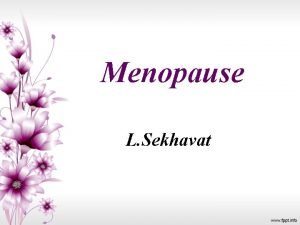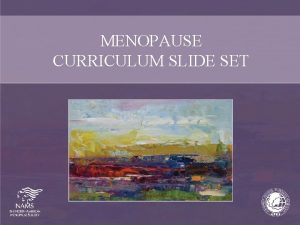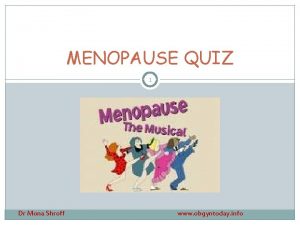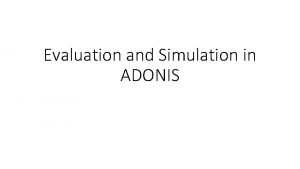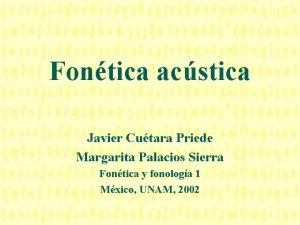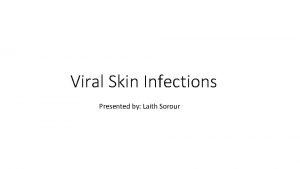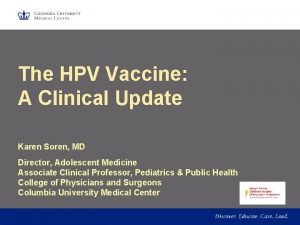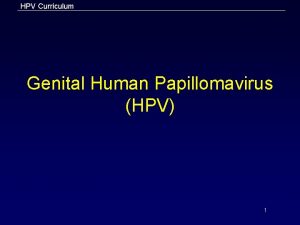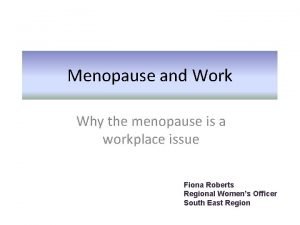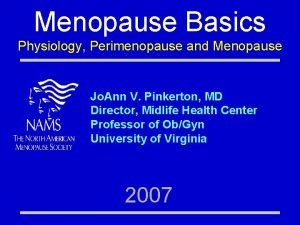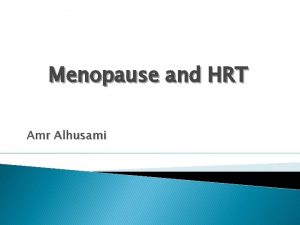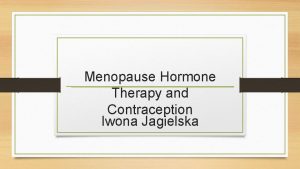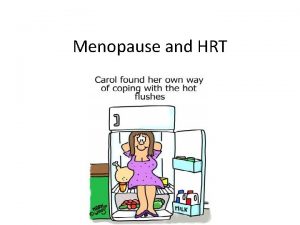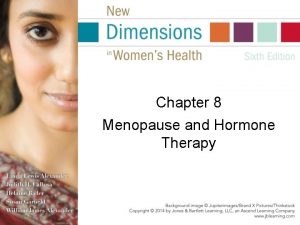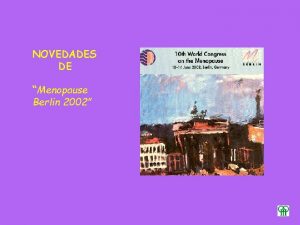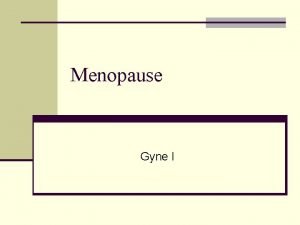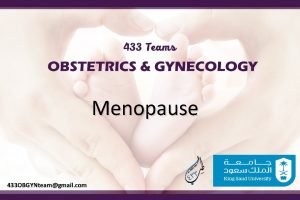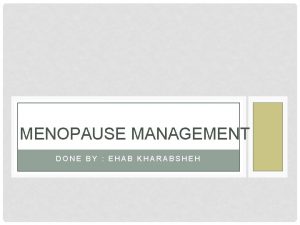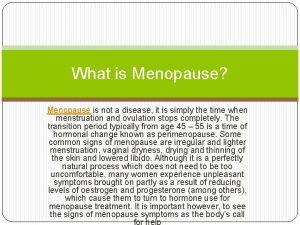Case 4 Menopause and HPV Dr Santiago Palacios



















- Slides: 19

Case 4 Menopause and HPV Dr. Santiago Palacios

Introduction • The maximum prevalence of HPV occurs in women between 18 and 25 years of age. • However, we sometimes forget that women in peri and post-menopause can also have HPV. In addition, their ability to produce antibodies is lower than in young women and therefore, HPV infection could be higher risk. • The CLEOPATRE study conducted in Spain found an HPV prevalence of 9% in women age 45 -55 and 7% in women age 56 -651. • In fact, the majority of cervical cancers in Spain are detected in women over 50 years of age and, specifically, 27% of cancers are diagnosed in women over age 65 2. • Therefore, the detection and management of HPV in women in peri- and postmenopause is critical for the prevention and early detection of cervical cancer. 1. Castellsagué X, et al. The CLEOPATRE study. J Med Virol. 2012 Jun 2. Bruni L, et al. Human Papillomavirus and Related Diseases in Spain. Summary Report 10 December 2018

Introduction Prevalence of HPV in Spain 1 Prevalence of HPV, % Annual number of new cases of cervical caner Cervical cancer in Spain 2 Age Groups 60 -64 years: 159 cases 55 -59 years: 212 cases 50 -54 years: 248 cases 45 -49 years: 257 cases 40 -44 years: 235 cases Age Groups (Years) 1. Castellsagué X, et al. The CLEOPATRE study. J Med Virol. 2012 Jun 2. Bruni L, et al. Human Papillomavirus and Related Diseases in Spain. Summary Report 10 December 2018

Question 1 In post-menopause, a woman with HPV: 1. Has no risk of developing a cervical lesion 2. Has greater ease in developing antibodies than younger women 3. Has a lower capacity for immune response than younger women

Reason for consultation • 61 year-old patient who consults in December 2018 for the first time to our clinic. She wants to have cytology and HPV determination performed. She says she is worried because she has started to have intercourse with a new partner and tells us that at 52 years of age, she was diagnosed with ASC-US positive for HPV 16, with the cytology normalizing and then being negative for HPV determination a year later.

Medical History • 61 years of age. 4 pregnancies with normal deliveries. • Smoker of 4 cigarettes per day. • Divorced 22 years ago, then had several partners and has had a new partner for the last 4 months. • Hypothyroidism taking Eutirox 50 mg/day. Arthritis of the right knee. • Appendectomy and breast augmentation • Menopause at 51 years of age, taking Hormone Replacement Therapy for 5 years. • Not vaccinated against HPV.

Action • The patient requests cytology and HPV determination. • A gynecologic examination is performed, cytology, and a sample is obtained for HPV determination. Results • Gynecologic examination clinically compatible with postmenopausal woman. Vulvo-vaginal atrophy. • Normal cytology with signs of atrophy. • HPV determination. Positive for 16.

Results Examination Cytology

Results It is decided to perform a colposcopy RESULTS • No atypical vessels, no aceto-white lesions, no transformation zone. • Cervix appears atrophied. • No biopsies taken.

Results Colposcopy

Discussion We pose three questions 1. For a patient who previously had HPV 16 and has it again with apparently normal cytology and colposcopy. Do we do nothing and wait a year, or. . . 2. This is a post-menopausal patient with atrophy. Should we prescribe local estrogens? 3. She has never been vaccinated. Should we recommend it?

Discussion For a patient who previously had HPV 16 and has it again with apparently normal cytology and colposcopy. Do we do nothing and wait or. . . • We talk to the patient and effectively decide to perform viral messenger RNA determination of the E 6/E 7 oncogenes. • The E 6/E 7 oncogenes are recognized as responsible for initiation and progression of invasive tumors. For their detection, there a series of commercial techniques that differ substantially insofar as the HPV genotypes evaluated (5 or 14) and the analytic method (quantitative or qualitative). DNA tests locate certain HPV genes, but do not allow the differentiation between the mere presence of the virus and active infection. On the contrary, m. RNA tests detect an active HPV infection that is susceptible to give rise to pre-cancerous lesions.

Discussion Viral m. RNA for E 6/E 7 oncogenes: NEGATIVE • Aptima HPV assay 3 • We tell the patient she can relax because she does not have an active infection 3. Aptima HPV assay. www. hologic. com

Question 2 Viral m. RNA determination of E 6/E 7 oncogenes 1. Is used to determine the type of papillomavirus. 2. Indicates an active HPV infection. 3. Does not detect HPV.

Discussion This is a post-menopausal patient with atrophy. Should we prescribe local estrogens? • There are data to suggest that the use of local estrogens can improve the transformation zone, making a biopsy more feasible 4. • Moreover, this is a post-menopausal woman with clear vulvo-vaginal atrophy and who is sexually active. • We discuss with the patient and decide to prescribe treatment with vaginal estriol suppositories (2 times per week). 4. María Teresa Bruno et al. Virology journal Volume 16 : 39 (2019)

Discussion For these two questions • If I already have an HPV positive determination, can I be vaccinated? Answer: Yes • If I am post-menopausal, can I be vaccinated? Answer: Yes We recommend Vaccination with Gardasil 9®

Discussion • Women with infection by one of the types protected against obtain high levels of protection against the other types covered by the vaccine. • Vaccination against HPV of women previously infected with HPV has a favorable safety profile and generates a high level of immune response. • In productive infections, HPV vaccination may reduce: 1. Dissemination of virions towards the transformation zone. 2. Transmission of virions to their partner. AEPCC Guide. Prevención secundaria cáncer de cuello de útero [Secondary prevention of cervical cancer] 2014

Question 3 In post-menopause, a woman: 1. Does not benefit from being prescribed the vaccine. 2. The vaccine only works if she has not had HPV before. 3. The vaccine has a good response and a favorable safety profile.

Conclusions Do not forget that women in peri- and post-menopause have: • A lower capacity for immune response to HPV. • A greater probability of persistent infections, especially of the most oncogenic types. • A greater potential risk of developing premalignant lesions or cancer over time.
 Rosa maría palacios aurelio palacios moreyra
Rosa maría palacios aurelio palacios moreyra Menopause and mania
Menopause and mania Symplex f for menopause
Symplex f for menopause Menopause definition
Menopause definition What is menopause
What is menopause Premature menopause quiz
Premature menopause quiz Menopause wann
Menopause wann Menopause defination
Menopause defination Ana maria palacios ecuavisa
Ana maria palacios ecuavisa Patricia palacios mackay
Patricia palacios mackay Katrina cohen-palacios
Katrina cohen-palacios Ruben caceres palacios
Ruben caceres palacios Adonis simulation
Adonis simulation Perla amorene anaya
Perla amorene anaya Puertas del paraiso ghiberti analisis
Puertas del paraiso ghiberti analisis Margarita palacios sierra
Margarita palacios sierra Cristhian palacios
Cristhian palacios Cultura minoica
Cultura minoica Hpv type 16 and 18
Hpv type 16 and 18 Hpv type 16 and 18
Hpv type 16 and 18



